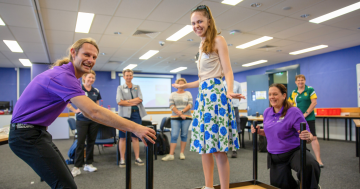Michelle Gibbings* has advice for facilitating a meeting in a way that does not leave participants wondering whether the whole thing has been a waste of time.
 Back in my corporate days, I would regularly spend my entire day in back-to-back meetings.
Back in my corporate days, I would regularly spend my entire day in back-to-back meetings.
I’d rush from meeting to meeting and feel a spark of joy when a meeting was cancelled.
“Hooray, some time back in my day,” I would say to myself.
Today, the meeting culture in most organisations is still pervasive, and during the pandemic we spent more and more time in meetings.
A Harvard University study found people attended 13 per cent more meetings, and the number of people attending each meeting increased, although meetings on average were 20 per cent shorter.
There’s no doubt that meetings and virtual meetings are here to stay.
Meetings are supposedly an opportunity to connect, debate, decide and learn, yet sadly, the meeting’s intent is often missing or missed.
Many people dread them for a number of reasons including:
They rarely start and finish on time — some people arrive late, others leave early, and some people don’t turn up.
There’s often no clear purpose or agenda, and so there are varying levels of preparation.
The meeting isn’t well chaired, and so the conversation wanders and is dominated by a few loud voices.
You can often leave a meeting having achieved little and then think that was a waste of time.
I’ve read an excellent article that challenges you to explore the psychology that sits behind why we hold meetings and to break through the expectations and assumptions that constrain us.
It’s critical to challenge yourself and consider: “Does this need to be a meeting?” Often it’s not the only option.
When you do need to meet, you will want to make the meeting worthwhile.
As I’ve written about before, there are things you can do to elevate your meeting’s effectiveness.
What is often missing from a meeting is facilitation.
It is by facilitating a conversation that you can best secure genuine collaboration.
A great facilitator knows how to draw out the ideas and thoughts of others and to balance competing and diverse perspectives.
They can ensure that everyone involved feels heard and valued.
They pay attention to what is happening around them — both the ‘saids’ and ‘unsaids’.
They are working with the participants to genuinely bring out the best in each other, which is the ultimate benefit of collaboration.
When a leader applies facilitation skills in team meetings and discussions, they ensure people feel heard, recognising the positive impact on team engagement.
When a person feels heard, they feel like they matter to you.
They feel like their point of view has been considered and that you are interested in what they have to say.
Being heard doesn’t mean you need to agree with the other person’s perspective.
It means you are fully present when the person is talking to you.
You are genuinely interested in what they are saying, asking questions and seeking to clarify before sharing your ideas or providing a solution.
Facilitators know they don’t have all the answers.
Instead, the wisdom is in the room, and it’s their role to guide conversations so that those answers, thoughts and perspectives are surfaced and shared.
As Sam Kaner wrote in the Facilitator’s Guide to Participatory Decision-Making, “the facilitator’s job is to support everyone to do their best thinking.
“To do this, the facilitator encourages full participation, promotes mutual understanding, and cultivates shared responsibility.”
In taking this approach, there are a couple of factors to consider:
The session’s agenda may be fluid, which means that while the session is outlined in advance, it is open to being shifted and shaped by the participants on the day.
This approach helps to secure buy-in and shared accountability for the session’s outcomes.
Focus on understanding and connection, so that at the session’s start, you devote time to checking in and uncovering participants’ hopes and expectations.
The session is well facilitated, which requires you to consider whether you need an independent facilitator who does not have a stake in the outcome.
It is appropriately constructed to ensure a range of ways people can share ideas and provide feedback, thereby accounting for different communication styles and comfort levels.
The facilitator is adept at seeing and sensing what is being said and unsaid in the room and actively seeks to surface ideas, insights and concerns.
By doing this, everyone who attends feels like they have had the chance to participate and contribute.
A safe space is created for participants to share, debate and contribute to the day’s content, and dissenting opinions are not shut down.
Instead, people are curious about all ideas presented.
Learning how to facilitate isn’t just a useful skill for professional facilitators.
It’s a lifelong skill that is valuable in all professional domains and is a skill that will never go out of fashion.
*Michelle Gibbings is a Melbourne-based change leadership and career expert and founder of Change Meridian. She can be contacted at [email protected].
This article first appeared atwww.changemeridian.com.au.












